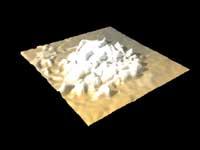North of Mars freezes faster

In their simulations they have been able to verify that if the difference in height of the surface of Mars is not taken into account, the air circulation changes radically, since the South Pole of Mars is six kilometers above the North Pole. To understand it better it is necessary to know that the high mountain of Tibet is four kilometers of average height above sea level.
According to the researchers, this height difference is the main cause of this imbalance in air circulation. This imbalance causes, in general, the transport of water vapor from south to north, derived from the ice that melts in summer in each hemisphere.
The eccentricity of the orbit of Mars around the Sun could also influence this asymmetry of atmospheric circulation, but in the simulations made by Richardson and Wilson it has been observed that this parameter has given different values and there have been no large differences. The eccentricity of the orbit sets the minimum distance from Mars to the Sun.
As on Earth, the gas in the atmosphere of Mars is heated in the equator and ascends by convection, cools when it reaches the poles and falls back to the equator. As a consequence of this effect, in both hemispheres there is a swirl in the form of gingil: Hadley's cells.
Hadley cells carry water vapor and dust from the surface of the planet. In the drills it is observed that the Hadley cell of southern Mars moves faster and leaves the equator, thus displacing water vapor and dust to the north.

In 1990 it was observed that the north pole and the south pole of Mars are not equal. The northern ice is very steep and full of holes, in addition to a very homogeneous distribution. In the south, on the other hand, ice adopts unique and rare forms caused by erosion.
This discovery allows predicting the ice that will form at the poles. Dust and ice will accumulate alternately in layers, but as calculated by Richardson and Wilson, they will accumulate more rapidly in the north. However, we still see Mars too far to check everything announced. In addition, the composition of ice on Mars is not clear, that is, how much water is and how much carbon dioxide is. All this is expected to be clarified from the data to be sent by the Mars Odyssey spacecraft.
Buletina
Bidali zure helbide elektronikoa eta jaso asteroko buletina zure sarrera-ontzian











